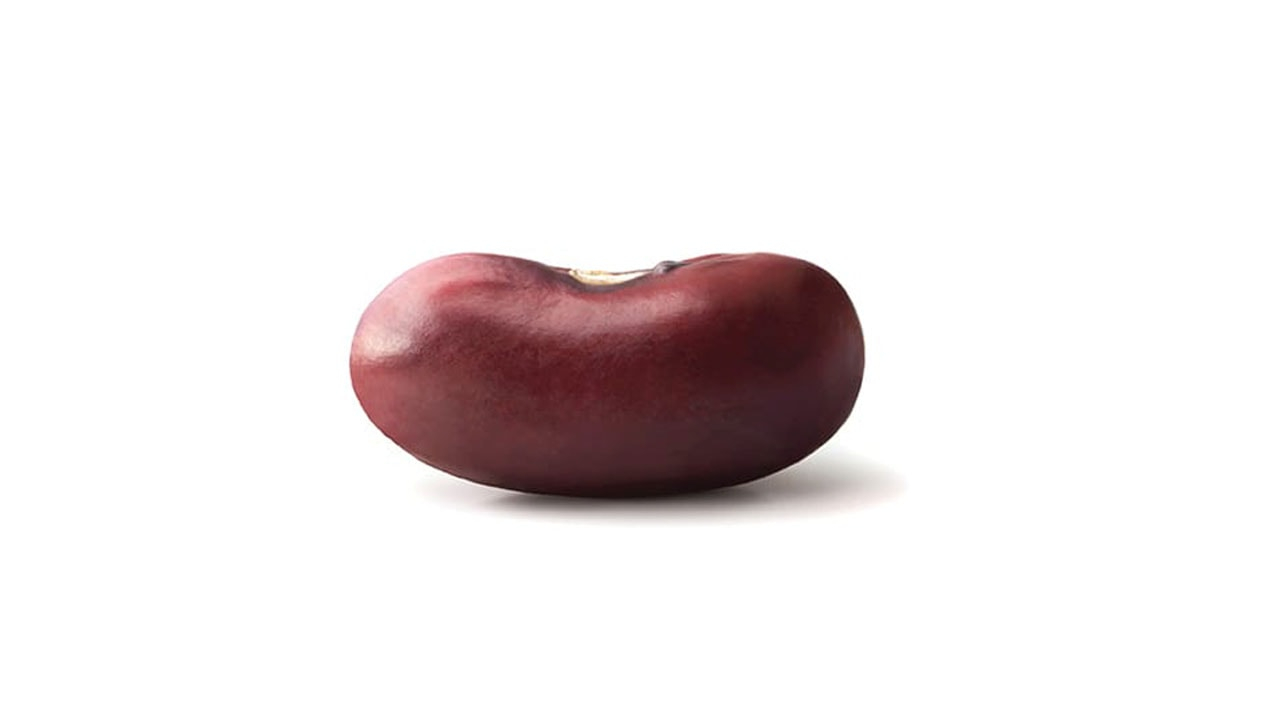Many thousands of Americans are waiting on a kidney transplant, sometimes for as long as five years. And kidney disease is a particular burden for many Alabamians. But by transplanting gene-edited pig kidneys into an individual who had been declared brain dead, a UAB team has delivered a breakthrough that may end the burden of waiting.
IT ALL BEGAN AT UAB IN 1966.
That’s when a young physician named John Kirklin, M.D., decided to take a chance on the fledgling UAB Department of Surgery and accept the offer to become their new chair. Before coming to UAB, Kirklin had revolutionized cardiac surgery at the Mayo Clinic.
A respected surgeon on a rocket-ship ride to a renowned career, he shocked transplant doctors across the country by choosing UAB—a young institution located in the Deep South—during the height of the Civil Rights Movement. His goal: establish a top-notch transplant program that could compete with the nation’s best.
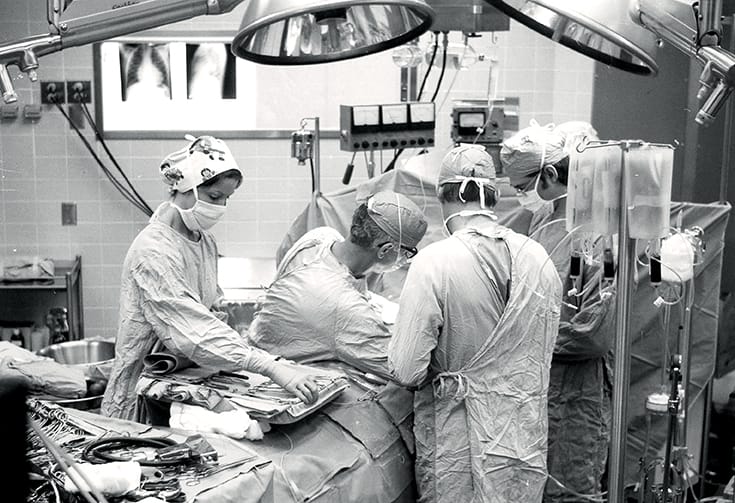 John Kirklin, M.D., in surgery.
John Kirklin, M.D., in surgery.
Joined in 1967 by the young Arnold G. Diethelm, M.D., who had trained under renowned surgeon and eventual Nobel Prize recipient Joseph Murray, M.D., in Boston, Kirklin began to build the first transplant program in the Southeast.
Murray’s first transplant in 1954 had been a success, but it relied on a donor who was an identical twin to the recipient, which meant their shared genes vastly reduced the risk that the transplanted kidney would be rejected. The failures of subsequent procedures that relied on unrelated donors led to public criticisms of Murray and other transplant surgeons.
“Back in the 1960s, renal transplantation was still in its infancy,” says Carlton Young, M.D., director of the Birmingham Veteran's Administration's adult kidney transplant program and Children’s of Alabama’s pediatric kidney transplant program. “Dr. Diethelm would often say the most common transplant was putting a kidney in, and the second most common surgery was taking them out.”
But Kirklin and Diethelm persisted, and in 1968, the UAB team was ready to perform the first kidney transplant in Alabama. Navy veteran Hollis Milton Lucas received a kidney from his brother, making his procedure the first of the more than 16,000 transplants that have since been performed at UAB via its Comprehensive Transplant Institute. Only the University of California-San Francisco has performed more kidney transplants than UAB since statistics began being kept on Jan. 1, 1988. In fact, from Jan. 1, 1988, through Dec. 31, 2021, UAB performed 9,055 kidney transplants, according to the United Network for Organ Sharing, including almost 3,435 living donor transplants.
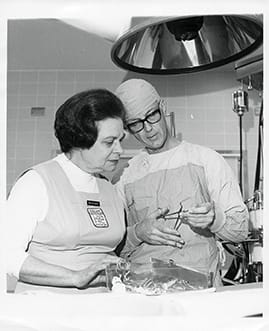 Dr. Kirklin with a nurse in the operating room.
Dr. Kirklin with a nurse in the operating room.“Drs. Kirklin and Diethelm exemplified the aggressive commitment to excellence in service, collaboration, and innovation for which UAB has become known around the world,” said UAB President Ray Watts, M.D. “The foundation they laid has continued to bring some of the brightest minds in the field to Birmingham and the southeast—where the disease burden is significant—to save and improve thousands of lives.”
Because of Kirklin’s and Diethelm’s vision, and the investment of resources and talent over the ensuing five decades, UAB has been able to pioneer new medications, advance research, and improve surgical techniques while serving some of the poorest and most marginalized patients—a fitting legacy of Kirklin’s bold step to choose Birmingham in 1966.
The Chain
Kidney disease kills more people each year than breast or prostate cancer, according to the National Institute of Diabetes and Digestive and Kidney Diseases. Although transplantation is the gold standard treatment for end-stage kidney disease, fewer than 25,000 kidney transplants are performed each year in the United States, and 240 Americans on dialysis die every day.
The wait for a deceased donor kidney can be five years or more and in many states, it is closer to 10 years. Almost 5,000 people on the kidney waiting list die each year. UAB physicians say that knowing there is a life-saving therapy available to doctors, but a limited supply of organs, is the most challenging part of their job. “The hardest part is seeing patients in clinic and wait-listing them knowing that they might actually die before I ever get an organ-offer to transplant them,” says Jayme Locke, M.D., director of the Comprehensive Transplant Institute in the Heersink School of Medicine Department of Surgery.
Thankfully, much has changed since the 1950s and 1960s, when donor-recipient incompatibility and a lack of immunosuppressant drugs meant poor outcomes for many transplant patients. With those advances, UAB has been able to build the South’s leading incompatible kidney-transplant program, which makes transplantation possible between some donors and recipients who otherwise would not match. This process enabled doctors to transplant more patients in unique ways, including through a chain of transplants known as a kidney chain.
Many transplant programs require a completely compatible match, and some donor-recipient pairs in the kidney chain are compatible matches. But UAB has the ability to make matches even when pairs are incompatible due to differences in blood group or tissues. Pretreatment desensitization, which may include removing reactive antibodies from the recipient’s blood, using drugs to lower numbers of reactive immune cells, or reducing the ability of immune cells to respond and proliferate, overcome those differences and allow for the survival of an incompatible kidney.
UAB began what has become a record kidney chain on Dec. 5, 2013, when Pelham, Alabama, resident and donor Paula King approached UAB about the possibility of donating a kidney to a stranger in need. King was committed to donating a kidney despite not having an intended recipient. In a paired transplant chain, a donation like this can set off a series in which family or friends of recipients give a kidney to another person in need—essentially paying donations forward on behalf of a loved one.
King’s altruistic gift began a chain of transplants that involves people from multiple states, including Alabama, Florida, Georgia, Mississippi, Illinois, Louisiana, New Jersey, North Carolina, Oregon, Tennessee, Texas, and Virginia.
UAB’s kidney chain is now the world’s longest at 126 transplants.
“To me, these are miracles,” says Locke. “This is a life-changer for these patients and their families and friends. Every time someone comes forward to be a living kidney donor—whether they know someone they want to donate to or on behalf of—I just marvel at it,” Locke said. “They are all extraordinary individuals, and they really represent the very best of our country and the world.”
ALABAMA IS A HOT SPOT FOR KIDNEY DISEASE
Of the 37 million Americans living with kidney disease, a significant number of those people live in Alabama.
“Regionally, the high incidence of kidney disease in the southeast is a major complication of other diseases such as hypertension, obesity, and diabetes,” says Anupam Agarwal, M.D., executive vice dean and professor of nephrology in the Heersink School of Medicine.
“Black/African Americans, Latinx, and Hispanic communities, and other underrepresented minorities have a much higher predisposition to kidney disease,” he says. “This disparity could be related to genetic factors, specifically a gene called apolipoprotein L1 (APOL1)—a component of high-density lipoprotein that transports cholesterol and certain fats through the bloodstream from the body’s tissues to the liver. Mutations in the APOL1 gene render Black/African Americans more susceptible to kidney disease.”
Plus, with increased incidences of high blood pressure and other underlying conditions, the chances of kidney disease are much higher in communities of color.
In the same way, Agarwal says, social determinants of health deeply contribute to the kidney disease burden in Alabama, an issue that has been publicly exposed by the COVID-19 pandemic.
“Diet and salt intake, access to health care, and access to exercise make a huge difference in kidney health,” he says. “We still see patients who show up in the emergency room who have never had their blood pressure checked and have never seen a doctor in their entire lives due to mistrust in medicine and/or lack of access to health care. They have end-stage kidney disease needing emergent dialysis and ultimately a transplant.”
Agarwal says the best treatment for kidney disease is prevention, particularly since kidney disease does not cause any pain during early stages. “Staying up-to-date on annual physicals is a great way to stay protected,” he says.
Agarwal also says that kidneys can be protected by eating a well-balanced diet, aiming for a healthy weight, managing blood pressure, reducing stress, and exercising. For those living with diabetes, having blood glucose maintained with treatment can help prevent kidney disease.
—By Mary Ashley Canevaro
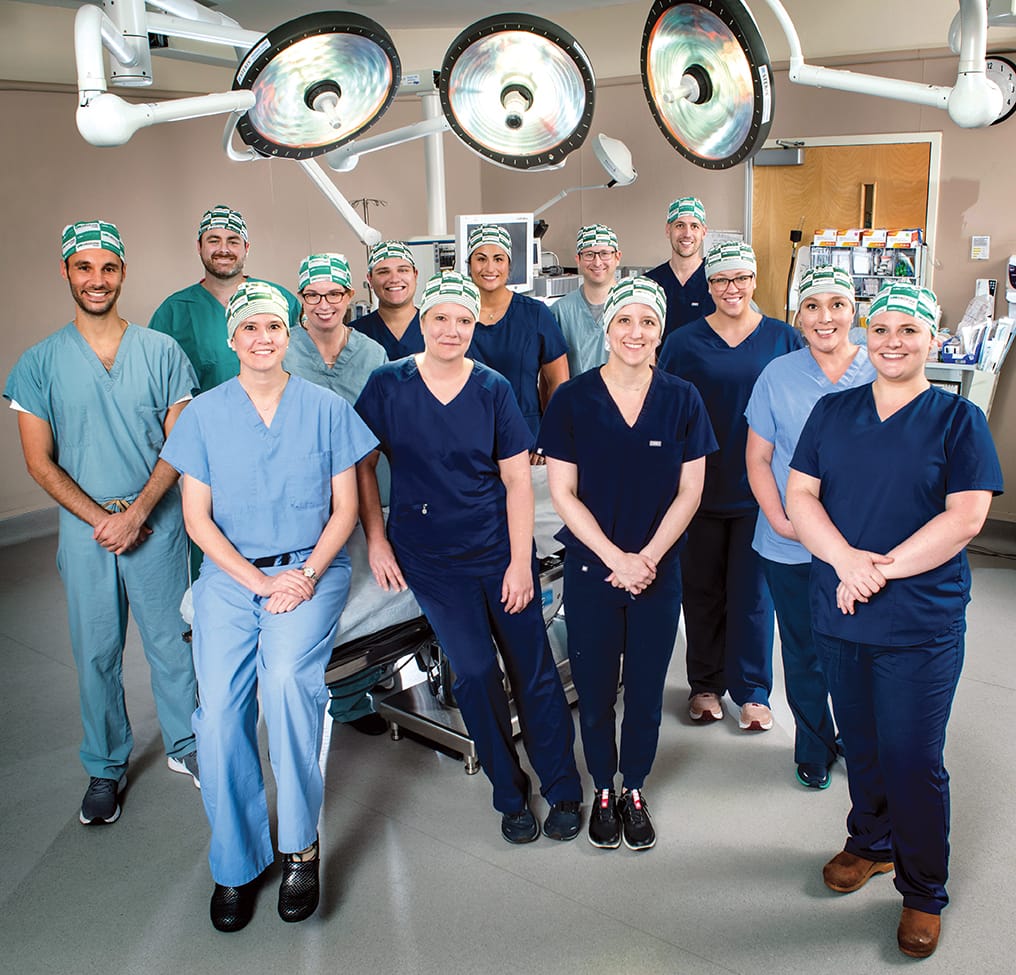
A New Frontier
But a new approach may one day end the need for the kidney chain.
Fifty-three years after Kirklin and Diethelm transplanted the first kidney in Alabama, Locke and her team have tested the first human preclinical model for transplanting genetically modified pig kidneys into humans. They published their results on January 20, 2022, in the “American Journal of Transplantation”.
Transplanting an animal organ into a human to cure disease is called “xenotransplantation.” Utilizing genetically modified pig kidneys could provide an increased supply for those needing a kidney transplant.
The study was conducted to meet the standards directly comparable to those that would apply to a Phase I human clinical trial, mirroring—as much as possible—every step of a standard transplant between humans. It included Institutional Review Board and Institutional Animal Care and Use Committee approval; a tissue-compatibility confirmation before starting the operations; using the standard procedures of human-to-human transplants to remove, preserve, transport, and transplant the kidneys into a human; and giving the standard immunosuppression therapy to the recipient.
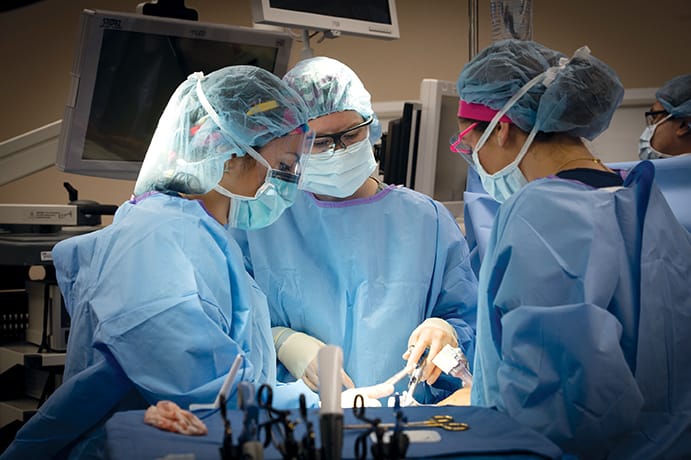 Jayme Locke, M.D., performing a kidney transplant.
Jayme Locke, M.D., performing a kidney transplant.For the first time, the kidneys transplanted were taken from a pig that had been genetically modified with 10 key gene edits that may make the kidneys suitable for transplant into humans. The study recipient had the two genetically modified pig kidneys transplanted in his abdomen after his native kidneys were removed. The organs were procured from a genetically modified pig at a pathogen-free facility.
This process demonstrates the long-term viability of the procedure and how such a transplant might work in the real world. The transplanted kidneys filtered blood, produced urine, and, importantly, were not immediately rejected. The kidneys remained viable until the study was ended, 77 hours after transplant.
“This game-changing moment in the history of medicine represents a paradigm shift and a major milestone in the field of xenotransplantation, which is arguably the best solution to the organ shortage crisis,” says Locke. “We have bridged critical knowledge gaps and obtained the safety and feasibility data necessary to begin a clinical trial in living humans with end-stage kidney disease.”
This effort is supported by biotechnology pioneer United Therapeutics Corp., which awarded a grant to UAB to launch the innovative xenotransplantation program. Revivicor, Inc., a subsidiary of United Therapeutics, provided the genetically modified pig that was the source of the investigational xenotransplant kidneys called UKidney™.
ABOUT THE XENOTRANSPLANT STUDY
UAB's peer-reviewed research on xenotransplantation is a study of ambitious scope and great significance, given that more than 800,000 Americans are living with kidney failure. Most never make it to the waiting list, and far too few human organs are available to put a dent in that number. Although dialysis can sustain life for some time, transplantation offers a better quality of life and a longer life for the few individuals who can gain access to transplantation. Each stage of this decedent xenotransplant study approximated the steps that might be taken in a Phase I xenotransplant clinical trial.
- The kidneys were removed from a donor pig housed at a pathogen-free, surgically clean facility. The kidneys were then stored, transported, and processed for implantation, just as human kidneys are.
- Before surgery, the brain-dead recipient and pig donor underwent a UAB-developed crossmatch compatibility test to determine whether the genetically modified pig kidney and its intended recipient were a good tissue match. Researchers made 10 gene edits in the pig kidneys: Three deletions disabled genes that would trigger rejection, and a fourth deletion prevented the pig kidneys from growing too large. The rest were human genes added to the pig genome to prevent the recipient’s immune system from attacking the organs.
- The pig kidneys were placed in the exact anatomic locations used for human donor kidneys, with the same attachments to the renal artery, renal vein and the ureter that carries urine from the kidney to the bladder.
- The brain-dead recipient received standard immune-suppression therapy used in human-to-human kidney allotransplantation.
The "Parsons Model"
But this scientific and medical breakthrough would not have been possible without Jim Parsons and his family.
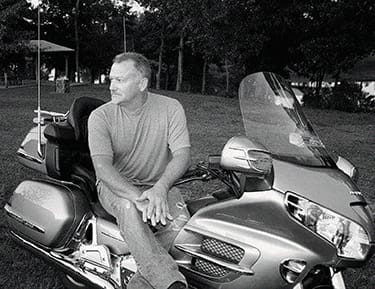 Jim had a passion for motorcycles and raced off-road dirt bikes competitively.
Jim had a passion for motorcycles and raced off-road dirt bikes competitively.Parsons, 57, was a registered organ donor through Legacy of Hope, Alabama’s organ procurement organization, and though he had longed to have his organs help others upon his death, his organs were not suitable for donation. His family permitted UAB to maintain Parsons on a ventilator to keep his body functioning during the study. His native kidneys were removed, and two genetically modified pig kidneys were transplanted.
“Mr. Parsons and his family allowed us to replicate precisely how we would perform this transplant in a living human. Their powerful contribution will save thousands of lives, and that could begin in the very near future,” Locke says. “Mr. Parsons’ gift honors his legacy. We also believe that it firmly establishes the viability, safety, and feasibility of this preclinical model, which we have proposed to be known as ‘The Parsons Model.’”
Parsons’ ex-wife, Julie O’Hara, and their children, Ally, David, and Cole, made the decision (along with Jim’s sisters and mother) to take part in the study after they were approached by Locke and Alan Spriggs with Legacy of Hope.
“Jim was a never-met-a-stranger kind of guy who would talk to anyone and had no enemies—none,” O’Hara says. “Jim would have wanted to save as many people as he could with his death, and if he knew he could potentially save thousands and thousands of people by doing this, he would have had no hesitation. Our dream is that no other person dies waiting for a kidney, and we know that Jim is very proud that his death could potentially bring so much hope to others.”
Life-Changing Impacts
Locke says that xenotransplantation promises the consistent availability of compatible, genetically modified organs for patients in desperate need. If many people are compatible for a xenograft from a pig, that—paired with human-to-human allotransplantation—could potentially wipe out the kidney transplant waiting list. Many of the 5,000 people on a waiting list who die every year could be saved if an unlimited supply of kidneys were available.
“The opportunity to have an organ that is waiting there for the person who needs it is just overwhelming to think about,” she says.
As Locke and her team continue to progress their research and move to the next phase of their study, the implications of UAB’s breakthrough cannot be overstated.
“We have made significant investments in xenotransplantation for almost a decade hoping for [these] kinds of results,” says Selwyn Vickers, M.D., dean of the Heersink School of Medicine and CEO of the UAB Health System and UAB/Ascension St. Vincent’s Alliance. “[This is] a remarkable achievement for humanity and advances xenotransplant into the clinical realm.”
“The many breakthroughs in transplant at UAB,” Watts says, “have been made possible by the pioneers who very purposefully built a visionary foundation for success and made strategic investments, by our faculty and staff who dedicate themselves every day to improving and saving lives, and by those—like Jim Parsons’ family—whose selfless acts serve the greater good.”
“I feel very privileged to be just a tiny part of a really big puzzle that people have been working on for many years,” Locke says.
